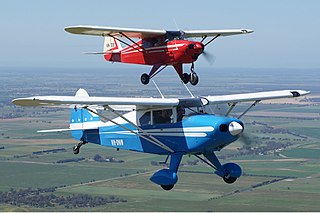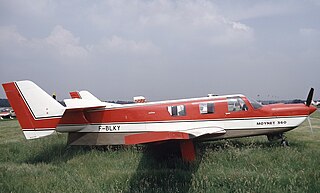Related Research Articles

The Piper PA-28 Cherokee is a family of two-seat or four-seat light aircraft built by Piper Aircraft and designed for flight training, air taxi and personal use. The PA-28 family of aircraft comprises all-metal, unpressurized, single-engined, piston-powered airplanes with low-mounted wings and tricycle landing gear. They have a single door on the right side, which is entered by stepping on the wing.

The Piper PA-24 Comanche is an American four-seat or six-seat, low-wing, all-metal, light aircraft of semimonocoque construction with tricycle retractable landing gear. Piper Aircraft designed and developed the Comanche, which first flew on May 24, 1956. Together with the PA-30 and PA-39 Twin Comanches, it made up the core of the Piper Aircraft lineup until the production lines for both aircraft were destroyed in the 1972 Lock Haven flood.

The PA-20 Pacer and PA-22 Tri-Pacer, Caribbean, and Colt are an American family of light strut-braced high-wing monoplane aircraft built by Piper Aircraft from 1949 to 1964.

The Piper PA-44 Seminole is an American twin-engined light aircraft manufactured by Piper Aircraft.

The Beechcraft Musketeer is a family of single-engined, low-wing, light aircraft that was produced by Beechcraft. The line includes the Model 19 Musketeer Sport, the Model 23 Musketeer, Custom and Sundowner, the Model 23-24 Musketeer Super III the retractable gear Model 24-R Sierra and the military CT-134 Musketeer.

The Piper PA-18 Super Cub is a two-seat, single-engine monoplane. Introduced in 1949 by Piper Aircraft, it was developed from the Piper PA-11, and traces its lineage back through the J-3 to the Taylor E-2 Cub of the 1930s. In close to 40 years of production, over 10,000 were built. Super Cubs are commonly found in roles such as bush flying, banner towing and glider towing.

The Grumman American AA-5 series is a family of American all-metal, four-seat, light aircraft used for touring and training. The line includes the original American Aviation AA-5 Traveler, the Grumman American AA-5 Traveler, AA-5A Cheetah, and AA-5B Tiger, the Gulfstream American AA-5A Cheetah and AA-5B Tiger, the American General AG-5B Tiger, and the Tiger Aircraft AG-5B Tiger.

The Aviat Husky is a tandem two-seat, high-wing, utility light aircraft built by Aviat Aircraft of Afton, Wyoming.

The American Champion 8KCAB Decathlon and Super Decathlon are two-seat fixed conventional gear light airplanes designed for flight training and personal use and capable of sustaining aerobatic stresses between +6g and −5g. The Decathlon entered production in the United States in 1970 as a more powerful and stronger complement to the American Champion Citabria line of aircraft.

The SOCATA Rallye is a light aircraft that was manufactured by French aviation company SOCATA. It was originally developed during the 1950s by French aircraft manufacturer Morane-Saulnier as the MS.880.

The Partenavia P.64B/P.66B Oscar is an Italian two/four-seat, single-engined, high-wing monoplane built by Partenavia.

The DINFIA IA 45 Querandi was a 1950s Argentine twin-engined light transport aircraft built by the DINFIA.

The Robin DR400 is a wooden sport monoplane, conceived by Pierre Robin and Jean Délémontez. The Robin DR400 first flew in 1972 and is still in production. The current model is designated 'DR401'. It has a tricycle undercarriage and can carry four people. The DR400 has a 'cranked wing' configuration, with the dihedral angle of the outer wing much greater than the inboard, a configuration which they share with Jodel aircraft. This model is considered easy to fly by many and quiet during flight due to its wooden frame.

The Robin HR100 is a French four-seat light monoplane, designed by Chris Heintz and built by Avions Pierre Robin as metal-winged version of the Robin DR253 Regent.

The Malmö MFI-10 Vipan was a four-seat light utility monoplane designed and built in Sweden by Malmö Flygindustri. Only three aircraft were built and the type did not enter quantity production.

The Stout Skycar was a series of four one-off American light aircraft of the 1930s.

The Moynet M 360 Jupiter was a small executive transport built in France in the 1960s. It had an unusual twin-push-pull, single-fuselage configuration. Two prototypes were produced, the second with more power and seating, but no sales resulted.

The Turbay T-3A was an Argentine twin-engined seven-seater light transport of the 1960s. A single example was built, but no production followed.
The Backcountry Super Cubs Supercruiser is an American amateur-built aircraft, designed and produced by Backcountry Super Cubs of Douglas, Wyoming. The aircraft is based upon the design of the Piper PA-12 Super Cruiser and is supplied as a kit for amateur construction.

The Payen Arbalète was a small, pusher configuration, experimental French tailless aircraft, designed by Nicolas Roland Payen, and first flown in 1965.
References
Notes
- 1 2 3 "Home-built Deltas". Flight: 26. January 4, 1962. Archived from the original on March 4, 2016. Retrieved June 11, 2022.
- ↑ "American airplanes - Da - Dy". www.aerofiles.com. March 11, 2009. Retrieved December 24, 2014.